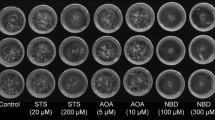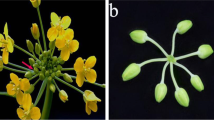Abstract
The effect of ZnSO4 concentration on barley (Hordeum vulgare L.) microspore embryogenesis was investigated using cultivars of different androgenetic response. Concentrations from 0 (control) to 600 μM in the stress pre-treatment medium alone or in combination with 30 (control) to 600 μM in the embryo induction medium were assayed in anther culture. Incorporation of Zn2+ in the pre-treatment medium itself did not affect microspore embryogenesis. The optimum concentration in the stress pre-treatment and induction media was 180 μM for cultivars (cvs.) Igri and Reinette, and 90 μM for cv. Hop. A significant increase of 30 and 300% in cv. Igri and Reinette, respectively, were produced with 180 μM ZnSO4 in both the number of embryos and green plants. In order to confirm the effect of Zn2+ on microspore embryogenesis this micronutrient was incorporated in the induction medium of isolated microspore cultures of cv. Igri. Concentrations of 90–300 μM ZnSO4 resulted in an increase of 40–53% in the number of embryos and green plants. All these results indicate that the beneficial effect of Zn2+ is exerted mainly during the culture phase, increasing the number of embryos, leading to an increased number of green plants, but it had no effect on percentage of regeneration or green plants.
Similar content being viewed by others
References
Bueno P, Piqueras A (2002) Effect of transition metals on stress, lipid peroxidation and antioxidant enzyme activities in tobacco cell cultures. Plant Growth Reg 36:161–167
Cakmak I (2000) Possible roles of zinc in protecting plant cells from damage by reactive oxygen species. New Phytol 146:185–205
Cakmak I, Marschner H, Bangerth F (1989) Effect of zinc nutritional status on growth, protein metabolism and levels of indole-3-acetic acid and other phytohormones in bean (Phaseolus vulgaris L.). J Exp Bot 40:405–412
Castillo AM, Vallés MP, Cistué L (2000) Comparison of anther and isolated microspore cultures in barley. Effects of culture density and regeneration medium. Euphytica 113:1–8
Chimienti F, Seve M, Richard S, Mathieu J, Favier A (2001) Role of cellular zinc in programmed cell death: temporal relationship between zinc depletion, activation of caspases, and cleavage of Sp family transcription factors. Biochem Pharmacol 62:51–62
Cistué L, Vallés MP, Echávarri B, Sanz JM, Castillo AM (2003) Barley anther culture. In: Maluszynski M, Kasha KJ, Foster B, Szarejko I (eds) Doubled haploid production in crop plants. A manual. FAO/IAEA Division, Wien, pp 29–35
Falchuk KH, Montorzi M (2001) Zinc physiology and biochemistry in oocytes and embryos. Biometals 14:385–395
He DG, Yang YM, Scott KJ (1991) Zinc deficiency and the formation of white structures in immature embryo cultures of wheat (Triticum aestivum L.). Plant Cell Tissue Organ Cult 24(1):9–12
Hirt H, Casari G, Barta A (1989). Cadmium-enhanced gene expresión in suspensión-culture cells of tobacco. Planta 179:414–420
Hoseini R, Mulligan BJ (2002) Aplication of rice (Oriza sativa L.) suspension culture on studying senescence in vitro (I). Single strand preferring nuclease activity. Electron J Biotechnol 5:42–54
Hossain B, Hirata N, Nagatomo Y, Akashi R, Takaki H (1997) Internal zinc accumulation is correlated with increased growth in rice suspension culture. J Plant Growth Reg 16:239–243
Huang C, Barker SJ, Langridge P, Smith FW, Graham RD (2000) Zinc deficiency up-regulates expression of high-affinity phosphate transporter genes in both phosphate-sufficient and deficient Barley roots. Plant Physiol 124:415–422
Hunter CP (1988) Plant regeneration from microspores of barley, Hordeum vulgare L. PhD Thesis. Wye College, University of London, London
Kintzios S, Drossopoulos JB, Lymperopoulos C (2001) Effects of vitamins and inorganic micronutrients on callus growth and somatic embryogenesis from leaves of chilli pepper. Plant Cell Tissue Organ Cult 67:55–62
Kobayashi A, Sakamoto A, Kubo K, Rybka Z, Kanno Y, Takatsuji H (1998) Seven zinc-finger transcription factors are expressed sequentially during the development of anthers in petunia. Plant J 13:571–576
Li ZS, Thomas TL (1998) PEI1, an embryo-specific zinc finger protein gene required for heart-stage embryo formation in Arabidopsis. Plant Cell 10(3):383–398
Maluszynski M, Kasha KJ, Foster B, Szarejko I (2003) Doubled haploid production in crop plants. A manual. FAO/IAEA Division, Wien, 428pp
Marschner H (1995) Mineral nutrition of higher plants, 2nd edn. Academic Press, New York, pp 33–347
Muñoz-Amatriaín M, Castillo AM, Chen X-W, Cistué L, Vallés MP (2008) Identification and validation of QTLs for green plant percentage in barley (Hordeum vulgare L.) anther culture. Mol Breed. doi:10.1007/s11032–008–9161-y
Murashige T, Skoog F (1962) A revised medium for rapid growth and bioassays with tobacco tissue cultures. Physiol Plant 15(3):473–497
Oguchi K, Tanaka N, Komatsu S, Akao S (2004a) Characterization of NADPH-dependent oxireductase induced by auxin in rice. Physiol Plant 121:124–131
Oguchi K, Tanaka N, Komatsu S, Akao S (2004b) Methylmalonate-semialdehide dehydrogenase is induced in auxin-stimulated and zinc-stimulated root formation in rice. Plant Cell Rep 22:848–858. doi:10.1007/s00299-004-0778-y
Pasternak TP, Rudas VA, Lörz H, Kumlehn J (1999) Embryogenic callus formation and plant regeneration from leaf base segments of barley (Hordeum vulgare L.). J Plant Physiol 155:371–375
Pulido A, Bakos F, Castillo AM, Vallés MP, Barnabas B, Olmedilla A (2005) Cytological and ultrastructural changes induced in anther and isolated-microspore culture in barley: Fe deposits in isolated-microspore cultures. J Struct Biol 149:170–181. doi:10.1016/j.jsb.2004.10.009
Saeki Y, Yasukouchi A, Nagatomo Y, Takaki H (2000) Distinctive expression of a zinc-biding protein in rice cell callus growth with high zinc concentration. Soil Sci Nutr 46:209–216
Skoog F (1940) Relationship between zinc and auxin in the growth of higher plants. Am J Bot 27:939–950
Teasdale RD (1986) Generation of sustainable Pinus radiate cell suspension culture and studies of cellular nitrogen nutrition. NZ J For Sci 16:377–386
Tsui C (1948) The role of zinc in auxin synthesis in tomato plants. Am J Bot 35:172–179
Wojnarowiez G, Jacquard C, Devaux P, Sangwan RS, Clément C (2002) Influence of copper sulfate on anther culture in barley (Hordeum vulgare L.). Plant Sci 162:843–847
Xu R, Li QQ (2003) A RING-H2 zinc finger protein gene RIE1 is essential for seed development in Arabidopsis. Plant Mol Biol 53:37–50
Yanagisawa S (2004) Dof domain proteins: plant specific transcription factors associated with diverse phenomena unique to plants. Plant Cell Physiol 45:386–391
Acknowledgements
We thank Dr. I Romagosa for statistical advice. M. Soriano was a recipient of a FPI fellowship from the Ministerio de Educación y Ciencia (MEC) of Spain. The research was supported by Projects AGL2002-04139-C02-02 and AGL2005-07195-C02-01 from Plan Nacional de Recursos y Tecnologías Agroalimentarias of Spain.
Author information
Authors and Affiliations
Corresponding author
Rights and permissions
About this article
Cite this article
Echavarri, B., Soriano, M., Cistué, L. et al. Zinc sulphate improved microspore embryogenesis in barley. Plant Cell Tiss Organ Cult 93, 295–301 (2008). https://doi.org/10.1007/s11240-008-9376-y
Received:
Accepted:
Published:
Issue Date:
DOI: https://doi.org/10.1007/s11240-008-9376-y




